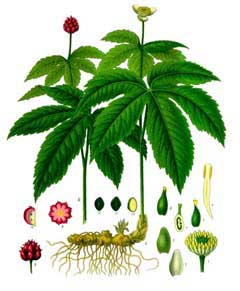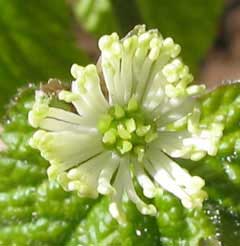 |
|
http://commons.wikimedia.org/wiki/File:Koeh-209.jpg |
 |
| http://commons.wikimedia.org/wiki/User:Phyzome |
Translate this page:
Summary
Physical Characteristics

 Hydrastis canadensis is a PERENNIAL growing to 0.3 m (1ft) by 0.3 m (1ft in).
Hydrastis canadensis is a PERENNIAL growing to 0.3 m (1ft) by 0.3 m (1ft in).
See above for USDA hardiness. It is hardy to UK zone 3. It is in flower from May to June, and the seeds ripen from July to August. The species is hermaphrodite (has both male and female organs).
Suitable for: light (sandy), medium (loamy) and heavy (clay) soils. Suitable pH: mildly acid and neutral soils. It can grow in full shade (deep woodland) or semi-shade (light woodland). It prefers moist soil.
UK Hardiness Map
US Hardiness Map
Synonyms
Hydrastis trifolia. Warnera canadensis. Warnera diphylla. Warnera tinctoria
Plant Habitats
Woodland Garden Dappled Shade; Shady Edge; not Deep Shade;
Edible Uses
References More on Edible Uses
Medicinal Uses
Plants For A Future can not take any responsibility for any adverse effects from the use of plants. Always seek advice from a professional before using a plant medicinally.
Antibacterial Antiperiodic Antiseptic Antispasmodic Astringent Cholagogue Diuretic Laxative
Sedative Stomachic Tonic
Goldenseal is a traditional medicine of the North American Indians and is still widely used in Western herbal medicine[4, 254]. In the Nineteenth century it acquired a reputation as a heal-all and was grossly over-collected from the wild and has become rare in the east of its range[213, 222]. It is now being cultivated on a small scale[4]. It is especially valued in treating disorders of the digestive system and mucous membranes and is also extremely useful in the treatment of habitual constipation[4, 254]. See also the notes above on cultivation needs[K]. The root is the active part of the plant, it is harvested in the autumn after the plant has died down and is dried for later use[4, 213]. It is said to be antiperiodic, antiseptic, astringent, cholagogue, diuretic, laxative, stomachic, tonic[4, 21, 46, 165, 222, 238]. It is used mainly in the treatment of disorders affecting the ears, eyes, throat, nose, stomach, intestines and vagina[254]. The root contains the alkaloids hydrastine, berberine and canadine[213]. Berberine is antibacterial (effective against broad-spectrum bacteria and protozoa[207]), it increases bile secretions, acts as an anticonvulsant, a mild sedative and lowers blood pressure[222]. Use of this plant destroys beneficial intestinal organisms as well as pathogens, so it should only be prescribed for limited periods (a maximum of three months)[238]. The plant should be used with caution, and not at all during pregnancy or by people with high blood pressure[222, 238]. An infusion of the root is used externally as a wash for skin diseases, vaginal infections, gum diseases etc[213, 238].
References More on Medicinal Uses
The Bookshop: Edible Plant Books
Our Latest books on Perennial Plants For Food Forests and Permaculture Gardens in paperback or digital formats.

Edible Tropical Plants
Food Forest Plants for Hotter Conditions: 250+ Plants For Tropical Food Forests & Permaculture Gardens.
More

Edible Temperate Plants
Plants for Your Food Forest: 500 Plants for Temperate Food Forests & Permaculture Gardens.
More

More Books
PFAF have eight books available in paperback and digital formats. Browse the shop for more information.
Shop Now
Other Uses
Dye Repellent
A yellow dye is obtained from the whole plant[4, 46, 61]. It is obtained from the root[95]. The pounded root is smeared on the body to act as an insect repellent[213].
Special Uses
Food Forest
References More on Other Uses
Cultivation details
Goldenseal is somewhat difficult of cultivation, it prefers a good rich moist loamy leafy soil in shade or partial shade[4, 31, 187]. Prefers a sandy, acid to neutral humus-rich soil[200]. Grows best in a pH range from 6 to 7[238]. Plants are hardy to at least -15°c[187]. Goldenseal is grown commercially as a medicinal plant[57], but it is not easy to establish the plants[4, 200]. Another report says that all goldenseal root that is used medicinally comes from wild plants[238]. Since the plant is becoming increasingly rare in many parts of its range, it is probably wise to try and find alternatives to this species for medicinal use unless you can be sure that your supply comes from cultivated plants[K].
References Carbon Farming Information and Carbon Sequestration Information
Temperature Converter
Type a value in the Celsius field to convert the value to Fahrenheit:
Fahrenheit:
The PFAF Bookshop
Plants For A Future have a number of books available in paperback and digital form. Book titles include Edible Plants, Edible Perennials, Edible Trees,Edible Shrubs, Woodland Gardening, and Temperate Food Forest Plants. Our new book is Food Forest Plants For Hotter Conditions (Tropical and Sub-Tropical).
Shop Now
Plant Propagation
Seed - sow autumn or early spring in a moist sandy loam in a shady part of the cold frame or greenhouse[1]. The seed is slow to germinate[238]. Prick out the seedlings into individual pots when they are large enough to handle and grow them on in light shade in the greenhouse for the first year or two. Plant out into their permanent positions when the plants are dormant. Division of the roots in autumn[4]. The roots can be divided into quite small pieces and can also be transplanted at almost any time of the year[4]. Larger clumps can be replanted direct into their permanent positions, though it is best to pot up smaller clumps and grow them on in a cold frame until they are rooting well. Plant them out in the spring.
Other Names
If available other names are mentioned here
Native Range
NORTHERN AMERICA: Canada (Ontario), United States (Connecticut, Massachusetts, New Jersey, New York, Ohio, Pennsylvania, Vermont, West Virginia, Illinois, Minnesota, Missouri, Nebraska, Wisconsin, Alabama, Arkansas, Delaware, Georgia, Maryland, North Carolina, Tennessee, Virginia)
Weed Potential
Right plant wrong place. We are currently updating this section.
Please note that a plant may be invasive in one area but may not in your area so it's worth checking.
Conservation Status
IUCN Red List of Threatened Plants Status :

Growth: S = slow M = medium F = fast. Soil: L = light (sandy) M = medium H = heavy (clay). pH: A = acid N = neutral B = basic (alkaline). Shade: F = full shade S = semi-shade N = no shade. Moisture: D = dry M = Moist We = wet Wa = water.
Now available:
Food Forest Plants for Mediterranean Conditions
350+ Perennial Plants For Mediterranean and Drier Food Forests and Permaculture Gardens.
[Paperback and eBook]
This is the third in Plants For A Future's series of plant guides for food forests tailored to
specific climate zones. Following volumes on temperate and tropical ecosystems, this book focuses
on species suited to Mediterranean conditions—regions with hot, dry summers and cool, wet winters,
often facing the added challenge of climate change.
Read More
Expert comment
Author
L.
Botanical References
43200270
Links / References
For a list of references used on this page please go here
Readers comment